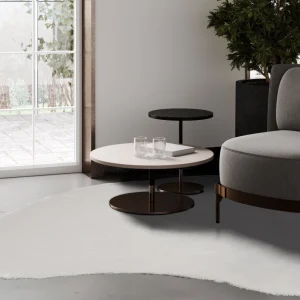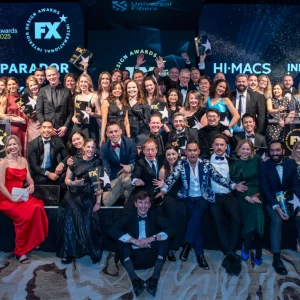IN THE SPRING OF 1973, heads were turning in downtown New York as Motorola engineer Martin Cooper strolled along the street talking on the world’s first mobile phone. Seeing someone on the move as they made a call was a sight to behold at a time before cordless telephones had even been invented. The shift from making calls to a person instead of a place represented a revolution in telecommunications, one that drew inspiration from science fiction, specifically Captain James T. Kirk’s handheld communicator from the popular television show Star Trek. In 1996, Motorola famously based the design of its flip-up ‘StarTac’ phone directly on Kirk’s device and it became a bestseller. In imagining potential futures, science fiction has influenced daily life in multiple ways, from the cars we drive and the clothes we wear, to the buildings in which we live and work, and the fittings, furniture and devices used within them. The symbiotic relationship between science fiction and design is the subject of the exhibition Science Fiction Design: From Space Age to Metaverse (18 May 2024 – 11 May 2025) at Vitra Design Museum’s Schaudepot space in Weil am Rhein, Germany. Featuring more than 100 objects from the museum’s collection, it explores how paradigms established by designers are pushed, extended and reimagined by science fiction, which in turn exerts its influence on the world of design.
Curated by Susanne Graner and Nina Steinmüller, the exhibition takes visitors on a journey from the early 20th century to the space age of the 1950s and 1960s, to recent design objects intended for the virtual worlds of the metaverse. In literature, the science fiction genre dates back to the 19th century, emerging in part as a response to rapid industrialisation and burgeoning new technologies. Pioneered by authors such as Mary Shelley and Jules Verne, it typically deals with advanced scientific and technological concepts such as space exploration and time travel as well as imagining what life might be like in the future.
 Eero Aarnio, Pallo/Ball Chair, 1963 © Vitra Design Museum Photo: Andreas Sütterlin
Eero Aarnio, Pallo/Ball Chair, 1963 © Vitra Design Museum Photo: Andreas Sütterlin
One of Edgar Allan Poe’s stories, The Unparalleled Adventure of One Hans Pfaall (1835), features a voyage to the moon, a concept that was explored by French filmmaker Georges Méliès in A Trip to the Moon (1902), one of the first science fiction films, which is being screened at the Schaudepot. Other early science fiction films include Fritz Lang’s legendary Metropolis (1927) with its spectacular sets and dazzling visual effects designed by Erich Kettelhut, whose original drawing depicting the palatial skyscrapers of an imagined future in which a pampered aristocracy are served by an exploited underclass is also on display.
 Erich Kettelhut, Drawing for Metropolis, 2nd Edition, 1925 © Deutsche Kinemathek – Museum für Film und Fernsehen, Erich Kettelhut Archive
Erich Kettelhut, Drawing for Metropolis, 2nd Edition, 1925 © Deutsche Kinemathek – Museum für Film und Fernsehen, Erich Kettelhut Archive
Filmmakers increasingly embraced science fiction over the following decades, as did graphic artists and a whole slew of authors, including Isaac Asimov, Ray Bradbury, Arthur C. Clarke and Philip K. Dick. In the 1960s, concepts anticipated by science fiction were becoming reality: satellites were being launched into orbit, rockets were taking cosmonauts and astronauts into space and even to the moon as a result of the space race rivalry between the Cold War superpowers of the US and Soviet Union. Designers were also hugely influenced by the space age and its attendant innovations, which fed into a modern vision for contemporary life.
 Olivier Mourgue, Djinn Lounge Chair, 1964/65 © Vitra Design Museum Photo: Jürgen Hans © VG Bild-Kunst Bonn, 2024
Olivier Mourgue, Djinn Lounge Chair, 1964/65 © Vitra Design Museum Photo: Jürgen Hans © VG Bild-Kunst Bonn, 2024
Space age design encompassed fashion, architecture, cars, furniture and objects for the home, bringing wonder and optimism for the future into everyday life. Organic forms, bold colours and shiny plastic surfaces were the order of the day, used in products that not only looked futuristic but reflected a shift in the way that designers were thinking about what it meant to be modern. Take, for example, the furniture of Italian designer Joe Colombo, whose Sella 1001 lounge chair (1964/65) and modular Living Center (1970/71) furniture pieces perfectly embodied the future-forward spirit of the space age.

Günter Ferdinand Ris, Herbert Selldorf, Sunball, 1969_71 © Vitra Design Museum Photo: Jürgen Hans
Flying saucers were a staple of science fiction illustration in the 1950s and 1960s, and famously inspired Matti Suuronen’s quirky Futuro House of 1965, a prefabricated fibreglass-reinforced polyester plastic home designed to be easily transportable and which could potentially be sited anywhere in the world. The Finnish architect also designed equally futuristic looking furniture. Included in Vitra’s exhibition is a revolving, fibreglass chair he created for Finland’s first all-plastic petrol station in 1969, the year that Apollo 11 first landed humans on the moon. In the same year, Maurice Calka designed his plastic P.-D.G.
 Lloyd Schwan, Statuette, 1995 © Vitra Design Museum Photo: Jürgen Hans
Lloyd Schwan, Statuette, 1995 © Vitra Design Museum Photo: Jürgen Hans
Desk in a similar spirit. Incorporating an integrated swivel chair, telephone, intercom and television screen, its sleek white minimalist curves wouldn’t look out of place on the Starship Enterprise. Moulded fibreglass also allowed Eero Aarnio to create his famous Pallo/Ball Chair (1963), the capsule-like form of which is reminiscent of an astronaut’s helmet. Olivier Mourgue’s 1964 Djinn lounge chair had a futuristic appeal that caught the eye of Stanley Kubrick, who included red versions on the space station in his visionary 1968 film 2001: A Space Odyssey. Indeed, Mourgue’s furniture was more future oriented than perhaps intended, seemingly anticipating built-in obsolescence. ‘Things should have a short life,’ he insisted in 1965, a sentiment that was reflected by his iconic Djinns, which, made from foam and jersey, had a tendency to disintegrate with use.
 Georges Méliès, still image from the film Le Voyage dans la Lune, 1902 © Public Domain
Georges Méliès, still image from the film Le Voyage dans la Lune, 1902 © Public Domain
Among the interior designers featured in the exhibition is Verner Panton, who drew on the forward-thinking creativity of science fiction and broke virtually every rule of interior design in the creation of his spectacular concepts for homes, offices and restaurants. ‘The main focus of my own work is on the overall result,’ he said, referring to his penchant for incorporating elements that affected human senses, feelings and physical movement. ‘Interaction with the setting is far more important than that with just a chair or any other object; a room, a colour, furniture, textiles and lighting must be considered as a whole. An attractive setting can only be created if all of its components are truly mastered.’ Panton’s Fantasy Landscape, which was designed for the chemical company Bayer and exhibited at the Visiona 2 exhibition in Cologne, Germany, in 1970 is a prime example of his futuristic vision for interior design.
 Patrick Jouin, Solid C2, 2004 © Vitra Design Museum Photo: Jürgen Hans
Patrick Jouin, Solid C2, 2004 © Vitra Design Museum Photo: Jürgen Hans
Presented onboard a pleasure boat, the cave-like installation, characterised by its vibrant colours, organic forms and synthetic textiles, is regarded as the climax of Panton’s creative vision. With luscious shades of violet and blue, and a glowing centre of red, yellow and orange, its floors, walls and ceilings flowed together without any clear transitions, creating an experience of colours and surfaces that surprised and wowed visitors.
 Joe Colombo, Sella, 1964/65 © Vitra Design Museum Photo: Jürgen Hans
Joe Colombo, Sella, 1964/65 © Vitra Design Museum Photo: Jürgen Hans
Iconic furniture designs have appeared in numerous science fiction films. Henrik Thor Larsen’s classic Ovalia Egg Chair from 1968 was used by Will Smith and Tommy Lee Jones in Barry Sonnenfeld’s Men in Black (1997), while Marc Newson’s Orgone Chair (1993) can be spotted in Ridley Scott’s 2012 film Prometheus. Set in the late 21st century, the film follows the crew of the spaceship Prometheus as they seek out the origins of humanity on a distant world. Newson’s chair, which leans heavily on the space age aesthetic, emerged from his experiments with new production methods and processes, specifically his desire to find a way of working with aluminium in fluid form.
 Maurice Calka, P.-D.G. Desk, 1969 © Vitra Design Museum Photo: Jürgen Hans © VG Bild-Kunst Bonn, 2024
Maurice Calka, P.-D.G. Desk, 1969 © Vitra Design Museum Photo: Jürgen Hans © VG Bild-Kunst Bonn, 2024
Scott’s celebrated 1982 film Bladerunner imagines a dystopian future Los Angeles where a fugitive group of synthetic humans, known as ‘replicants’ are being hunted down by burnt out cop Rick Deckard. Its moody, neo-noir aesthetic pulls from the past as much as the future. Deckard’s Frank Lloyd Wright-modelled apartment, for example, is lit by various 1950s lamps, including a vintage Lightolier desk lamp by Gerald Thurston and a Dazor Saucer Lamp. The film even features Charles Rennie Mackintosh’s Argyle Chair (1897), which despite being nearly 130 years old still has a futuristic feel with its attenuated lines and unusually high back topped with an enlarged oval headrest.
 Konstantin Grcic, Chair One, 2008 © Vitra Design Museum Photo: Andreas Sütterlin
Konstantin Grcic, Chair One, 2008 © Vitra Design Museum Photo: Andreas Sütterlin
 Andrés Reisinger, The Shipping, Tangled, 2021 © Reisinger Studio
Andrés Reisinger, The Shipping, Tangled, 2021 © Reisinger Studio
From the 1990s, computer-aided design, digitisation and 3D printing provided the impetus for a new wave of futuristic developments and at the Schaudepot are many examples of how the search for material innovations have inspired today’s designers. Patrick Jouin’s Solid C2 (2004) was the first furniture piece made using laser sintering, a type of 3D printing process that uses high powered lasers to sinter, or bind, finely powdered material into a solid structure. Formed from intersecting ribbons of crisscrossing material, the Solid C2 chair ignores furniture-making traditions in favour of the freeform shapes that 3D printing allows. Also on display is Joris Laarman’s Aluminium Gradient Chair (2014), the first chair to be printed in metal, and Jólan van der Wiel’s otherworldly Gravity Stool (2011), created from resin combined with iron filings and shaped using the power of magnets.
 Marc Newson, Orgone Chair, 1993 © Vitra Design Museum Photo: Jürgen Hans
Marc Newson, Orgone Chair, 1993 © Vitra Design Museum Photo: Jürgen Hans
While the exhibition majors on furniture, it also showcases other disciplines such as fashion, automotive design and a fascinating speculative architectural collaboration by ZYVA Studio and Charlotte Taylor titled Neo- Chemosphere (2021). The dreamlike building is an homage to John Lautner’s Chemosphere (1960), an octagonal modernist house perched high up in the Hollywood Hills and which resembles an alien spacecraft. Neo- Chemosphere is additionally a response to the Covid-19 pandemic and the broader threat of climate change, the two designers imagining a post-anthropocentric world in which their own octagonal dwelling is wedged between large pink rock forms in a surreal landscape.
 Verner Panton, Fantasy Landscape at the exhibition Visiona 2, Cologne, Germany, 1970 © Verner Panton Design AG, Basel
Verner Panton, Fantasy Landscape at the exhibition Visiona 2, Cologne, Germany, 1970 © Verner Panton Design AG, Basel
With a floor plan spanning 14m in diameter, the building’s peaceful interior is finished in white resin, creating a strong contrast with the alien, post-apocalyptic environment outside. Striking a balance between high modernist and space age design, the house is intended as a tribute to the visuals effects that first emerged in mid-1970s cinema. The designers cite films such as Alien, 2001: A Space Odyssey, Star Wars and Rollerball as key inspirations.

Louis Durot, Aspirale, approx. 1970 © Vitra Design Museum Photo: Andreas Sütterlin
 Complicated Sofa, The Shipping, 2021 Artwork by Andrés Reisinger © Reisinger Studio
Complicated Sofa, The Shipping, 2021 Artwork by Andrés Reisinger © Reisinger Studio
The exhibition has been designed by prominent Argentine visual artist and designer Andrés Reisinger, whose pared back installation of minimal grey shelves, frosted glass and mirrors, could easily double up as a set design for a Kubrick film. ‘As soon as I was invited by the Vitra Design Museum to work on this exhibition, I knew I wanted to incorporate the themes of Argentine fantasy writer Jorge Luis Borges, whom I’ve long admired,’ he explains. ‘A central motif in his work is mirrors, symbolic of portals to alternate realities.
 Joris Laarman, Aluminum Gradient Chair, 2013 © Vitra Design Museum Photo: Jürgen Hans
Joris Laarman, Aluminum Gradient Chair, 2013 © Vitra Design Museum Photo: Jürgen Hans
With this in mind, I resolved to honour Borges by making mirrors focal points of the exhibition, utilising them to reflect and evoke multiple realities and timelines intertwining.’ Several works by Reisinger are featured amidst his mirrored hallways, including Shipping Series (2021), which comprises ten surreal, digitally rendered furniture pieces that were marketed as NFTs. Some of the virtual items have been turned into real products, such as the extraordinary Hortensia Chair (2018), a futuristic looking seat inspired by hydrangea flowers. Other objects are described as ‘impossible’, including a bulbous pink table that resembles a balloon sculpture and a chrome storage unit with drawers balanced at different angles on an undulating frame.
 ZYVA Studio & Charlotte Taylor, Neo-Chemosphere, 2021 © Zyva Studio X Charlotte Taylor
ZYVA Studio & Charlotte Taylor, Neo-Chemosphere, 2021 © Zyva Studio X Charlotte Taylor
These virtual items are designed to be placed into virtual metaverse environments such as Decentraland, Somnium and Horizon Worlds.
 Andrés Reisinger, Hortensia, 2021 © Vitra Design Museum Photo: Andreas Sütterlin
Andrés Reisinger, Hortensia, 2021 © Vitra Design Museum Photo: Andreas Sütterlin
In light of the current space exploration efforts, such as Elon Musk’s stated ambition to facilitate the colonisation of Mars (truly the stuff of science fiction), there is talk of a second space age and it remains to be seen how the dialogue between science fiction and design will continue to evolve in the 21st century. Tim Berners-Lee is said to have found inspiration for the World Wide Web in Arthur C. Clarke’s short story Dial F for Frankenstein, in which a telephone network becomes sentient and takes over the world.
 Installation view Science Fiction Design: From Space Age to Metaverse © Vitra Design Museum Photo: Mark Niedermann
Installation view Science Fiction Design: From Space Age to Metaverse © Vitra Design Museum Photo: Mark Niedermann
Who can say what tomorrow’s works of fiction will inspire and how they will shape our living spaces. One thing is for sure though: as virtual reality and artificial intelligence continue to develop apace, the boundaries between sci-fi and design will become increasingly blurred. For a new generation of young designers, the metaverse is fast becoming what ‘the final frontier’ represented to their forebears in the 1960s, an exciting realm of possibility waiting to be filled with new ideas and concepts. But as Reisinger is quick to remind us: ‘We are not escaping from the material world anytime soon. Instead, I believe we are expanding our experience into a new hybrid era of extended reality, in which art and culture are freed from spatial and temporal constraints and the rules of experience are rewritten.’





